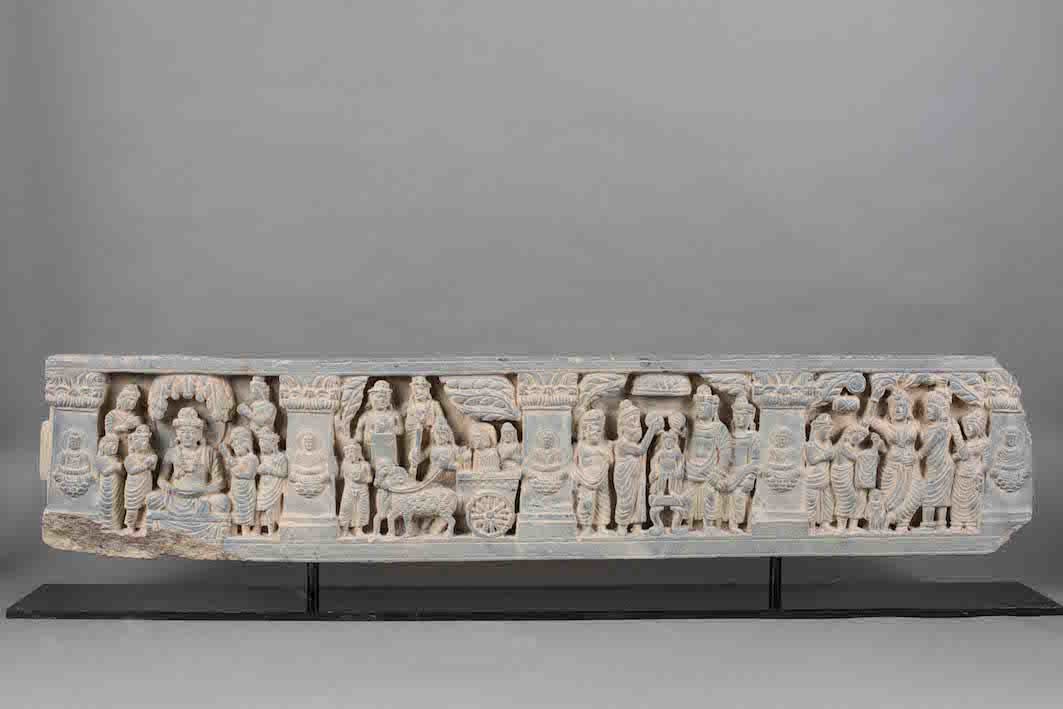Gandharan Relief Depicting Scenes from the Buddha's Life, 200 CE - 600 CE
Schist
21 x 105.2 cm
8 1/4 x 41 3/8 in
8 1/4 x 41 3/8 in
CB.3415
Further images
Gandhara’s geographical position, situated between the Persian world to the west and the Indian to the east, ensured that it was open to a wide variety of artistic influences. Often...
Gandhara’s geographical position, situated between the Persian world to the west and the Indian to the east, ensured that it was open to a wide variety of artistic influences. Often described as a ‘cultural melting pot,’ its strategic importance left it vulnerable to attack. Briefly in the hands of Alexander the Great between 327 -326 B.C., Greek artistic conventions long played an important role in local production. However whilst Gandhara clearly came under the influence of an extraordinary wide range of outside influences, it was also an exporter of ideas. This is most apparent in relation to the spread of Buddhism from India into other parts of Asia. Gandharan monks and scribes were particularly active in areas of China. According to tradition Buddhism was first introduced into the Gandharan region under the patronage of Asoka, emperor of the Mauryan dynasty, in the third century B.C. The first significant physical remains to survive, including stupas and figurative sculpture, date from the first century B.C. Between c.100-400 A.D. sculptors working in schist, terracotta and stucco produced an astonishing number and variety of Buddhist images. Among them, schist stone sculptures and reliefs of exceptional value has become the signature of Gandharan craftsmanship, which has been enthroned by some as the pinnacle of ancient Buddhist art.
This is an extremely rare schist relief panel in perfect condition. It elegantly depicts four important scenes of the Buddha’s life, separated by pillars bearing the image of Buddha Shakyamuni seated on a lotus blossom. The relief is to be viewed from right to left, corresponding to the clockwise circumambulation route in holy sites. The first scene depicts the birth of the Buddha. Resting herself along a tree, Queen Maya gives birth to the Buddha, who is conceived from the right side of his mother, accompanied by four royal servants. A holy birth without blood and filth, as well as that he could stand and talk the moment he is born, symbolise the merits he accumulated in his previous lives, as well as the ripening of those merits in this life. The second scene depicts the Buddha’s first shower after his birth. The Buddha in child form, standing at the center on a pedestal, is receiving a shower from four royal servants. The third scene depicts the Buddha’s first trip away from the palace to the city, when he is shocked by the pain and suffering invoked by birth, old age, illness, and death. This is the turning point in Buddha’s life, as he has always been living seclusively in the palace, where the suffering of the elements of life is basically non-existent. It stimulates the Buddha to seek a way to escape the inevitable suffering of being. The last scene depicts the enlightened Buddha. Seated under the bodhi tree, which is shaped like a chattra to symbolize royalty, the Buddha holds his hands in meditation mudra, denoting his enlightenment through meditation. He is accompanied by devotees who hold their hands together to pay respect.
This is an extremely rare schist relief panel in perfect condition. It elegantly depicts four important scenes of the Buddha’s life, separated by pillars bearing the image of Buddha Shakyamuni seated on a lotus blossom. The relief is to be viewed from right to left, corresponding to the clockwise circumambulation route in holy sites. The first scene depicts the birth of the Buddha. Resting herself along a tree, Queen Maya gives birth to the Buddha, who is conceived from the right side of his mother, accompanied by four royal servants. A holy birth without blood and filth, as well as that he could stand and talk the moment he is born, symbolise the merits he accumulated in his previous lives, as well as the ripening of those merits in this life. The second scene depicts the Buddha’s first shower after his birth. The Buddha in child form, standing at the center on a pedestal, is receiving a shower from four royal servants. The third scene depicts the Buddha’s first trip away from the palace to the city, when he is shocked by the pain and suffering invoked by birth, old age, illness, and death. This is the turning point in Buddha’s life, as he has always been living seclusively in the palace, where the suffering of the elements of life is basically non-existent. It stimulates the Buddha to seek a way to escape the inevitable suffering of being. The last scene depicts the enlightened Buddha. Seated under the bodhi tree, which is shaped like a chattra to symbolize royalty, the Buddha holds his hands in meditation mudra, denoting his enlightenment through meditation. He is accompanied by devotees who hold their hands together to pay respect.











